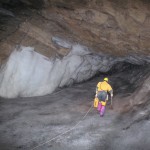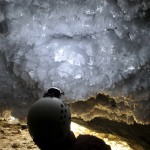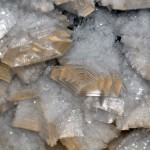Search Results for Tag: Siberia
Keep to +2 degrees might not prevent permafrost from melting
- Large Ice Hall in Ledyanaya Lenskaya Cave located inside continuous permafrost (Photo: (C): Sebastian FM Breitenbach)
- Frost crystals at the entrance of Ledyanaya Lenskaya Cave (Photo (C): Vladimir V Alexioglo)
- Close up of frost crystals (Photo (C): Vladimir V Alexioglo)
Large parts of the Northern hemisphere from Alaska to China hold a dangerous treasure. 24 percent of this land’s ground is frozen throughout the year – so called permafrost. It holds more than 1,000 gigatons of the most dangerous greenhouse gases: carbon dioxide and methane. Release of those would accelerate climate change to great extend.
Now, researchers found evidence that permafrost could start melting already at a 1.5 degrees Celsius rise in temperature. Also, the world already warmed up by 0.6 to 0.7 degree Celsius compared to the preindustrial level. So adding another 0.8 could already let permafrost melt.
That’s at least what happened in former times, as the scientists from Britain, Russia, Mongolia and Switzerland found out. They went into Siberian caves located along the ‘permafrost frontier’ studying stalactites and stalagmites as they function as a kind of climate archive – they only grow when liquid rainwater and snow melt drips from the surface into the caves.
“The stalactites and stalagmites from these caves are a way of looking back in time to see how warm periods similar to our modern climate affect how far permafrost extends across Siberia”, said Dr Anton Vaks of Oxford University’s Department of Earth Sciences, who led the work.
The amplifying effect on global warming the release of greenhouse gases held in the permafrost would have, exceeds everything climate models yet suggest. So, though almost 200 nations agreed in 2009 to the 2 degree target for global warming, this may not be enough to keep permafrost from melting and thus to mitigate climate change.
Warm Planet, Cold Winter
If you haven't noticed, winter has been especially harsh this year. Much of Northern Europe is in a deep freeze, and any passengers flying through London, Frankfurt or Paris know all too well what this winter has done to travel plans. The U.S. and Canada have been slammed with major snow storms that have left people stranded and desperate during the holiday season. And it's only December…
Some people are wondering: if the planet is getting warmer, why is it so cold? The New York Times has an interesting op-ed article about the reasons behind this trend. The author, Judah Cohen, says increased snow cover in Siberia actually has a major impact on our climate–but he believes scientists have ignored the region's role in warming and cooling earth.
Cohen says snow cover in Siberia has changed jet stream patterns, pushing more air north and south rather than just east and west. That's why Northern Europe and the U.S. have seen such extreme winter weather in recent years. What do you think? Is Cohen's theory a good explanation?








Feedback